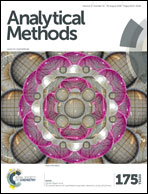Classification of iron ore based on acidity and alkalinity by laser induced breakdown spectroscopy coupled with N-nearest neighbours (N3)
Abstract
Laser induced breakdown spectroscopy (LIBS) coupled with N-nearest neighbours (N3) method was developed for classification and identification of four types of iron ore (acid iron ore, seiili-self fluxing iron ore, self-fluxing iron ore and alkaline iron ore). The parameters included spectral pretreatment methods and spectral range selection and the model parameter α was optimized at the same time by 5-fold cross validation and evaluated by average classification error rate. The region of 400–600 nm was normalized by maximum integrated intensity and used to construct the N3 and KNN (K nearest neighbor) models. The N3 and KNN models were evaluated and applied to discriminate iron ore. The classification accuracy is 100% for the N3 model, which shows better predictive capabilities than the KNN model for the classification of iron ore. Therefore, LIBS technique combined with N3 could be a promising method for real-time online, rapid analysis in mining and mineral processing industries.


 Please wait while we load your content...
Please wait while we load your content...